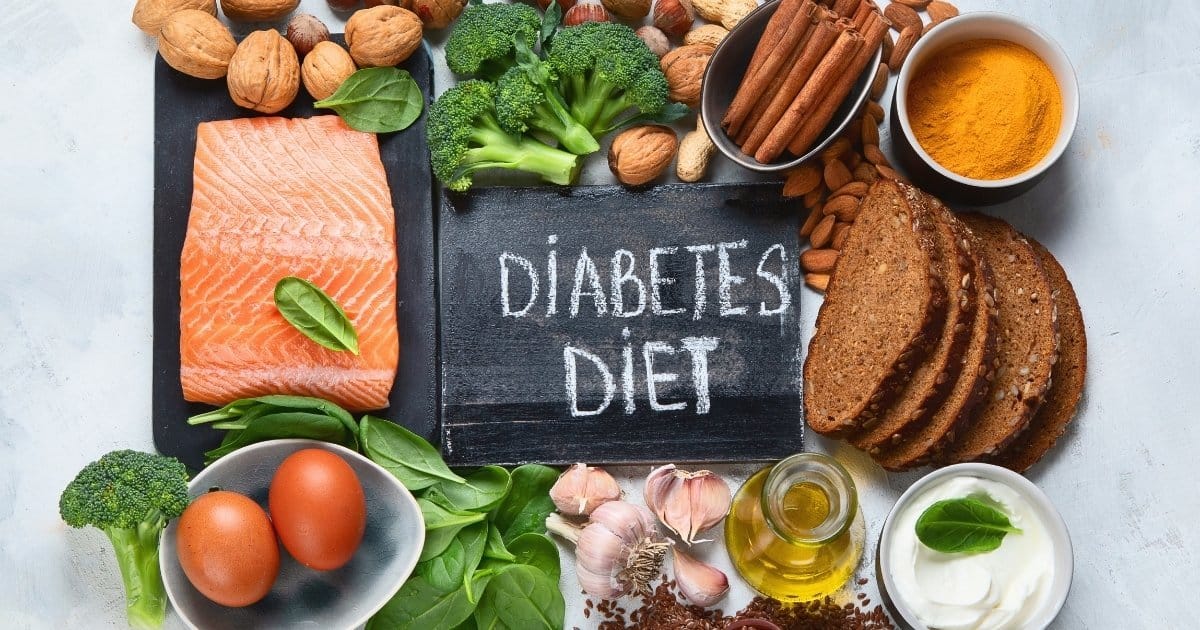Coming to terms with a gestational diabetes diagnosis is never easy (especially because most cases are diagnosed in the late second trimester when hormones are raging and you don’t exactly feel like yourself!).
Sometimes knowing what to eat and what to avoid can be the hardest change of all when following a gestational diabetes diet.
This article will explore what gestational diabetes is, what to eat, and what to avoid if you’re facing a diagnosis of your own.

What is gestational diabetes?
Gestational diabetes is a condition that occurs in pregnant women. It is a (normally temporary) state of insulin resistance and is usually diagnosed between 24 and 48 weeks of gestation.
This condition occurs when your body can no longer produce enough insulin to keep your blood sugars in normal range (between 80-120 mg/dL).
The condition usually goes away after the birth of your child, however, it does increase the risk of developing type 2 diabetes (for you and your baby) later on in life.
According to the Centers for Disease Control and Prevention (CDC), in the United States each year, between 5-9% of all pregnancies result in a gestational diabetes diagnosis.
It may sometimes require insulin injections and manually testing of your blood sugar levels, and almost always requires a change in dietary and exercise habits.
You can learn how to spot the signs of gestational diabetes and perform a simple blood test in our guide: How to Test for Gestational Diabetes.
Who is at risk for gestational diabetes?
While anyone can develop gestational diabetes, several groups of people are at higher risk of developing the condition, including those who:
- Had gestational diabetes during a previous pregnancy
- Are overweight
- Are older than 25 years old at the time of pregnancy
- Have a family history of type 2 diabetes
- Previously gave birth to a baby who weighed more than 9 pounds
- Has polycystic ovary syndrome (PCOS)
- Are African American, Hispanic or Latino American, American Indian, Alaska Native, Native Hawaiian, or Pacific Islander
What dietary changes are required?
While you should always work with your doctor to determine the best dietary changes for you, a good rule of thumb to begin with is cutting out added sugar and simple carbohydrates from your diet.
Balancing your meals and snacks is a key component to improving blood sugar levels. Fill your plate with lean protein, healthy fats, and whole produce while reducing your intake of starchy sides and processed foods.
Portion size also matters, so be sure to discuss your appropriate calorie and nutrient needs with your healthcare team.
Many doctors advise that you should cook more meals at home, so you know not only what ingredients you’re putting in your food, but the precise macronutrient breakdown, as well.
Talk with your doctor, because if your gestational diabetes is considered high-risk, you may need to see a Maternal Fetal Medicine (MFM) specialist or an obstetrician who specifically treats high-risk pregnancies.
What foods should I eat?
This is one of the most common questions pregnant women ask when they’re diagnosed with gestational diabetes. It can sometimes feel like there’s nothing you’re able to eat, especially if you’ve been put on insulin for the first time, or are experiencing severe insulin resistance.
Some foods that you should eat include:
- Plenty of green, leafy vegetables, like kale, spinach, cabbage, and romaine lettuce
- Bright vegetables, like bell peppers, carrots, sweet potatoes, and squashes
- Lots of fresh fruit, including strawberries, blueberries, raspberries, and coconut
- Whole grains, like steel-cut oatmeal, whole-grain breads, and pastas
- Healthy fats, like avocados, extra virgin olive oil, seeds, and nuts
- Lean proteins, like chicken and turkey, eggs and egg whites
- Fish, like salmon, mackerel, and white fish
- Healthy dairy, like lower-fat cheese, Greek yogurt, kefir, and low-fat milk
Eat 3 meals and 2–3 snacks per day
Eating smaller meals and snacks makes blood sugar control easier, as eating too much at one time (specifically too many carbohydrates) can cause your blood sugar to go too high.
Choose healthier carbohydrates
The type of carbs you eat or drink makes a big difference to your blood sugar levels. Choosing carbs that are minimally processed, low in simple sugars, and with a low glycemic index will help you keep your blood sugar stable.
Good sources of healthy carbohydrates include non-starchy vegetables such as broccoli, salad, and beans, and complex carbohydrates such as oats, brown rice, and whole-wheat bread.
Eat plenty of fiber
Dietary fiber slows down the rate of digestion which can help you better extract nutrients from the food you eat.
Because you digest high-fiber foods more slowly, they also help lessen blood sugar spikes after meals.
Good sources of fiber include:
- Beans and peas
- Low-carb fruits
- Oats (such as oat bran and oatmeal)
- Nuts and seeds
- Vegetables (such as cauliflower and green beans)
- Wheat bran
- Whole-grain foods (such as brown rice and whole-grain bread, cereals, and pasta)
Include protein in every meal
Protein is the building block for muscles and ligaments and is essential for muscle growth. It’s important for both you and your baby that you eat enough protein.
Protein also doesn’t spike your blood sugar.
It’s typically recommended that pregnant women eat 6-8 ounces of protein per day but work with your doctor to find a level that’s right for you.
Good sources of protein include:
- Lean beef or veal
- Cheese
- Chicken
- Cottage cheese
- Egg
- Fish and seafood (but read below about what fish and seafood to avoid)
- Pork
- Turkey
- Tofu
- Edamame
- Nuts/seeds
What foods should I avoid?
Perhaps more important than what you eat is what you avoid eating.
The following foods will increase inflammation and worsen blood sugars, which can increase insulin resistance and make your gestational diabetes management much more difficult:
- Sugar-sweetened beverages, like juice, sweet tea, and soda
- Energy drinks with excess caffeine
- High-calorie, high-sodium fast food (burgers, fries, etc.)
- Fried foods, like french fries and chips
- Highly processed foods
- Food with added sugar, like ice cream, cakes, donuts, muffins, and cookies
- High-fat red meats (lean cuts are fine)
- Alcoholic beverages
- Candy, like taffy and chocolates
- Refined grains, including white pasta and white rice
- Boxed cereals and sugar-sweetened granola bars and granola with more than 10 grams of sugar per serving
- Sweetened yogurts and milk products
Be careful with fish and shellfish
While seafood is healthy and should be included in a gestational diabetes diet, some types should be limited or avoided.
Large predatory fish like swordfish, shark, and marlin should be avoided completely as they can accumulate mercury and other toxins that are harmful to your and your baby.
You should eat no more than 2 portions (8-12 ounces) of oily fish a week, such as salmon, trout, mackerel, or herring. Oily fish can contain higher levels of pollutants than other types of fish.
Tuna (fresh or canned) should also be limited to 2 portions per week as tuna can also be high in mercury.
Completely avoid uncooked shellfish as they can have harmful bacteria, viruses, or toxins in them that can give you food poisoning.
Avoid raw or undercooked meats
There’s a small risk of getting toxoplasmosis if you eat raw and undercooked meat, which can cause miscarriage.
It’s recommended to avoid not only raw meat but also smoked meat and cold cuts such as salami, pepperoni, chorizo, and prosciutto that may not be fully cooked.
Liver and liver products such as pâté should also be avoided as they contain high levels of vitamin A that can be harmful to your baby.
Avoid unpasteurized milk and cheese
Pasteurization is the process of heating milk or milk products to 72°C for 15 seconds to destroy pathogens that can be harmful to humans.
Unpasteurized milk products have a small chance of containing listeria bacteria that can cause listeriosis and lead to miscarriage or stillbirth.
It’s also recommended to avoid cheeses with a white coating on the outside such as Brie, Camembert, and chèvre, as the coating can make it easier for bacteria to grow.
Other considerations
It’s important to note that even if you’re on exogenous insulin, simply taking insulin for sugary or processed foods will worsen insulin resistance, making your gestational diabetes harder to manage.
Life with gestational diabetes may require both prescribed medications, like insulin, along with lifestyle changes, such as improving your diet and increasing your physical activity.
However, because a diagnosis of gestational diabetes comes on suddenly, you don’t need to be a perfectionist about your diet, either.
Following the 80/20 rule, that is eating healthy 80% of the time and enjoying treats the other 20% of the time, can go a long way to improving your diet without becoming too stringent and not enjoying your pregnancy.
In addition to running any dietary changes by your doctor, you may also request to work with a registered dietitian (RD or a certified diabetes care and education specialist (CDCES) to map out an eating plan specifically tailored to your wants and needs.
How else can you stay healthy with gestational diabetes?
If you receive a gestational diabetes diagnosis during pregnancy, it can be scary, but if you take the proper steps to maintain and even improve your health, it will go a long way to preventing any potential birth complications for you and/or your baby.
Work with your doctor to make sure any new healthy habits you want to incorporate will work for your lifestyle and health goals, and that they can be a sustainable addition to your pregnancy routine.
Some strategies to consider include:
- Testing your blood sugar regularly
- Taking any insulin or medications prescribed by your doctor
- Going to all your regular prenatal appointments (you may have a few extra, given your diagnosis)
- Taking a prenatal vitamin daily
- Partaking in regular physical activity for at least 30 minutes a day, most days of the week
- Increasing your water intake
- Having mental health support, in the form of a support group
- Having an outlet for stress, such as yoga, meditation, journaling, or deep breathing
- Having support from family and friends
Conclusions
A gestational diabetes diagnosis may be serious, but it doesn’t have to completely sidetrack your pregnancy, and with careful lifestyle changes and monitoring, you can still have a completely healthy labor, delivery, and birth.
Always work with your doctor and care team to determine which lifestyle changes and/or monitoring and medication will be appropriate for you.
Some of the lifestyle changes you may have to make are in regard to your diet: what to eat and what to avoid.
Increasing your water intake, avoiding added sugars and processed foods, and focusing on including more healthy proteins, fats, and fresh fruits and vegetables will decrease inflammation and help curb insulin resistance for better blood sugars if you have gestational diabetes.
Also be sure to monitor your intake of carbohydrate-containing foods (or at least track them), increase your physical activity, and cook more meals at home. It may also be helpful to seek emotional and mental health support from family, friends, and potentially even a gestational diabetes support group (ask your doctor if they can refer you to any in your area!).
Remember that small changes can make all the difference in improving your health if you’re diagnosed with gestational diabetes while pregnant.




